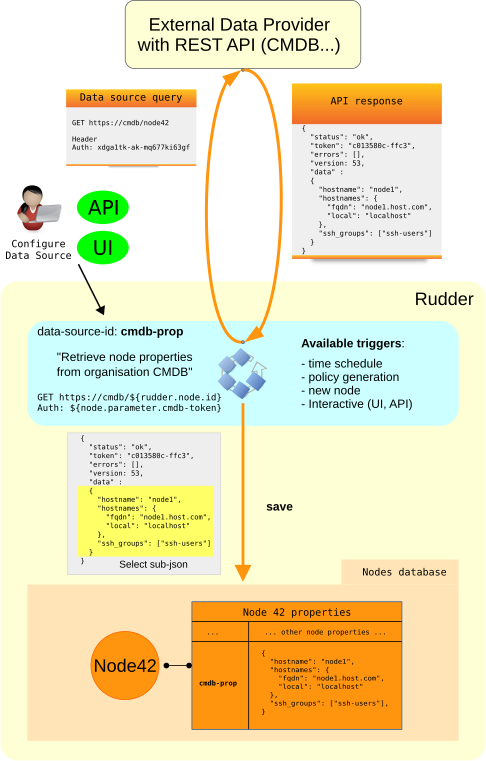Table of Contents
As explained in the chapter about node management, Nodes have properties that can be used to create groups or in techniques and directives parameters. These properties are key/value pairs, with values being a simple string or a well formed JSON document.
Rudder 4.1 introduces a new way to automatically import Node properties by defining data sources.
The following diagram explains the general working process of data source:

As displayed, a data source provides a way for Rudder to query (when some conditions are met) a third party REST API to retrieve interesting properties for nodes and save them for a given Node property key.
More precisely, there are three main sets of properties to define (by UI or via Rudder API) to configure a data source:
The first set of properties allows to define an unique identifier for the data source, which will be used as the property key in node, along with a human readable name and description.
The second set of properties allows to define how the third party REST API will be queried and the returned JSON response processed.
For now, we only support one query mode which is to do one HTTP query for each node. In the future, a mode where only one query is done to retrieve information for all nodes will be added.
For the query, you will define the HTTP method to use (GET or POST), what is the remote URL, if there are specific headers or query parameters to add.
In case a 404 error is returned, the corresponding node property is deleted (on that node). In case of a timeout or any other HTTP errors, this is considered a temporary problem, and the node property is left as is.
When a JSON document is returned, you can define a JSON path expression (cf https://github.com/jayway/JsonPath/) to select only a sub-part of the document as the actual data to use as a node property.
Finally, the resulting data is assigned to the node, using the key name defined in the data source configuration.
You can use Rudder variables expansion (${rudder.node.xxx},
${rudder.parameter.xxx}, ${node.properties[xxx]}) in most of these
configuration option: URL, headers, query parameters, JSON path. They will be
replaced by their values for each node at the time the HTTP query is run.
The last set of options allows to define when the data source should be queried.
For now, there are 3 available triggers:
- a scheduled one, allowing to periodically do the update,
- a trigger on policy generation, which allows to get a refresh of node properties before possibly using them in techniques or directives,
- a trigger on node acceptation, so that a new node immediately get a working set of properties (for example to join the correct dynamic groups).
In addition to these configured triggers, data sources can be interactively refreshed with a call to a Rudder REST API or via the web interface.

